
|
|
Für die deutsche Fassung bitte nach unten scrollen
|
|
Take a Walk with Us to Enjoy the
Beauty of Ancient Art
|
|
|
Art fairs, exhibitions, vernissages – everything we love about art events is currently not (yet) possible. But: Our showrooom in Vienna is open for you! Pass by and stroll with us through the millennia. In the last few months we have succeeded in acquiring numerous ancient masterpieces. In all price ranges. From Egypt to Rome.
|
Last but not least: If you are still looking for a millennia-old surprise for Easter, you have good chances of finding what you are looking for in the over 500 objects of the best provenances in our showroom.
|
|
|
|
Our Highlight of the Month:
|
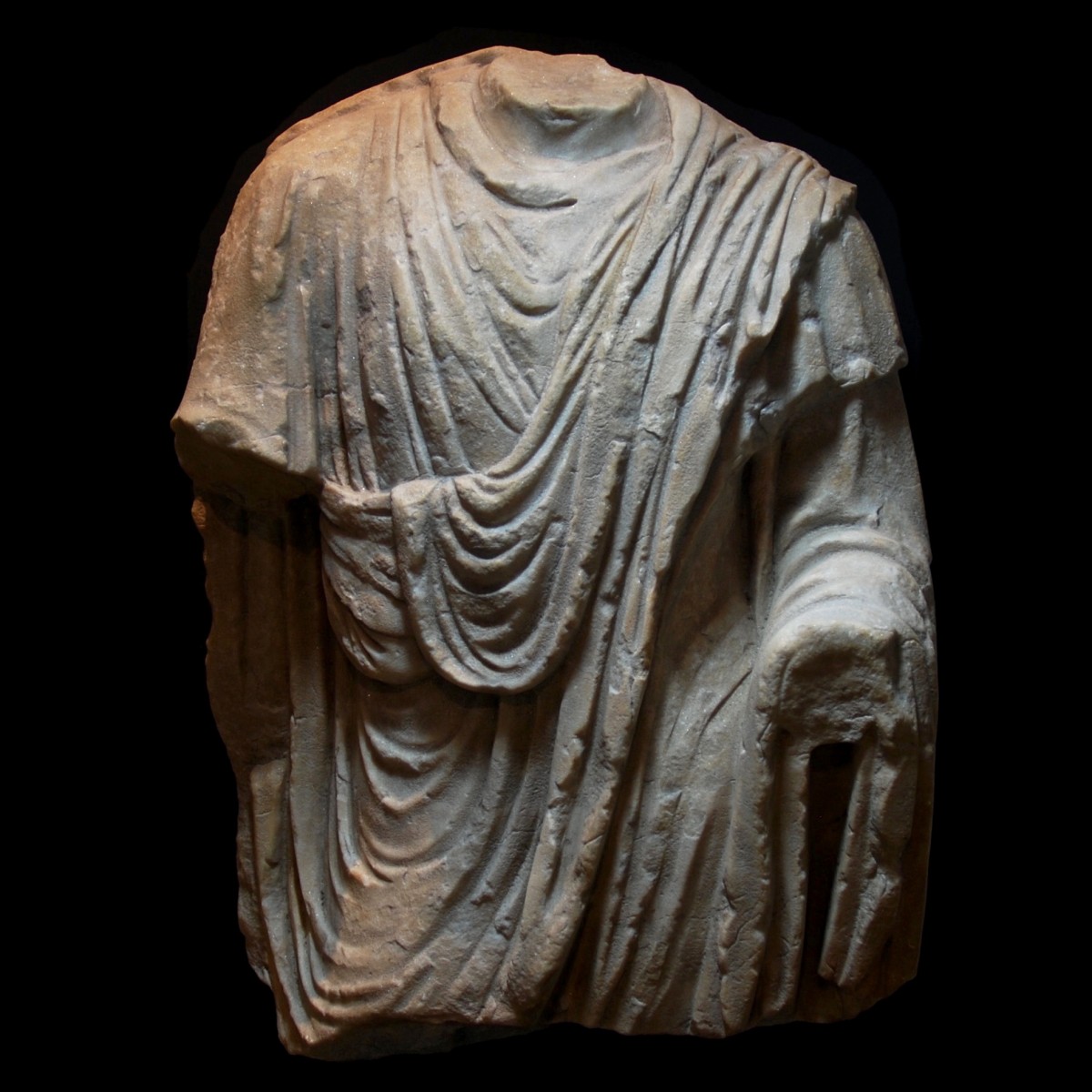
|
|
|
|
Roman Empire – 2nd century A.D.
|
Life-size fragment of a statue of a man wearing a tunic under a long, voluminous toga ("togatus"). The left arm is bent and stretched forward, the right arm hangs straight down along of the body. The toga runs horizontally over the stomach and is thrown over the left shoulder, the end piece is put over the draped horizontal part. With wonderfully elaborated, dense pleats.
|
Provenance: French private collection from the first half of 20th century. Last in a Parisian auction house.
Dimensions: 55 cm high
Price: 48 000 Euro
|
|
|
|
Selected Artworks of the Month:
|
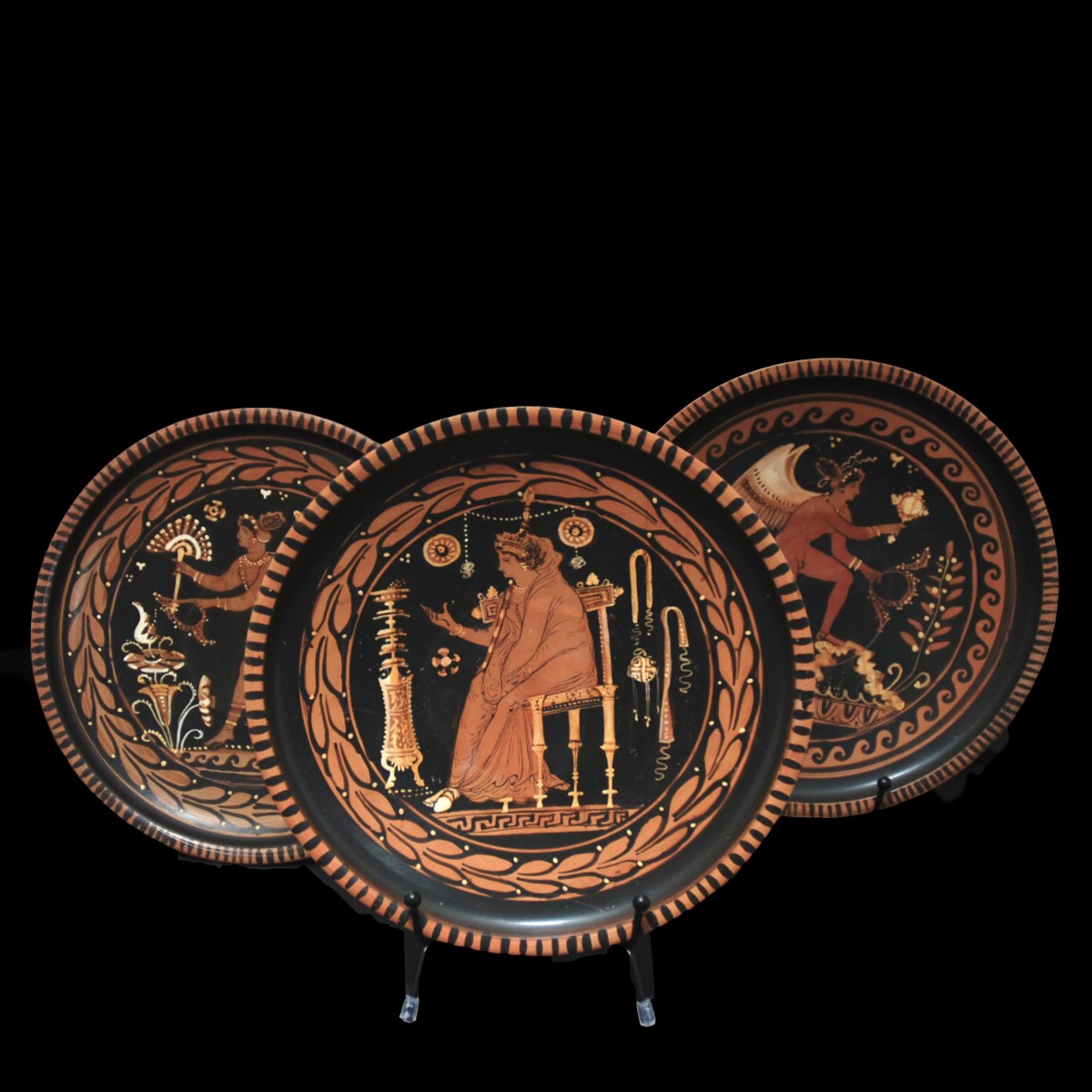
|
|
|
|
|
|
Greece/Apulia – 340-320 B.C.
|
An important ensemble of three extremely finely crafted, red-figured plates with details in opaque white, attributed by Arthur D. Trendall to the Menzies Group, Group of the Trieste Askoi. One plate depicts a seated goddess or priestess wrapped in a long gown. She holds a striped sceptre and wears a magnificent diadem. In front of her is a finely painted thymiaterion on curved animal legs. Behind the elaborately crafted throne of the goddess tainiae. The scene is framed by a band of laurel leaves. The other two plates each depict a nude Eros with open wings. On one of them, Eros is standing with his left leg on a rock and holding a mirror in front of his face. The other plate depicts Eros running to the left with a fan and a fillet. Elaborate flowers and plants decorate both scenes. The Eros on the rock is framed by a wavy band, the running one by laurel leaves. All three plates have tongues decoration on the rim and stand on finely profiled ring feet. The plates were attributed by the archaeologist Arthur D. Trendall, the expert in South Italian vase painting, in handwritten correspondence to the Menzies Group, to the subgroup of the Trieste Askoi, and are published in the "Supplements to the Red-figured Vases of Apulia".
|
Provenance: Private collection Michael Minnick, New York, acquired from Robert Peters, PhD, New York, in the 1980s. With a copy of the handwritten attribution by A.D. Trendall.
Dimensions: 22.6 cm, 22.6 cm and 22.8 cm in diameter
Price: 32 000 Euro
|
|
|
|
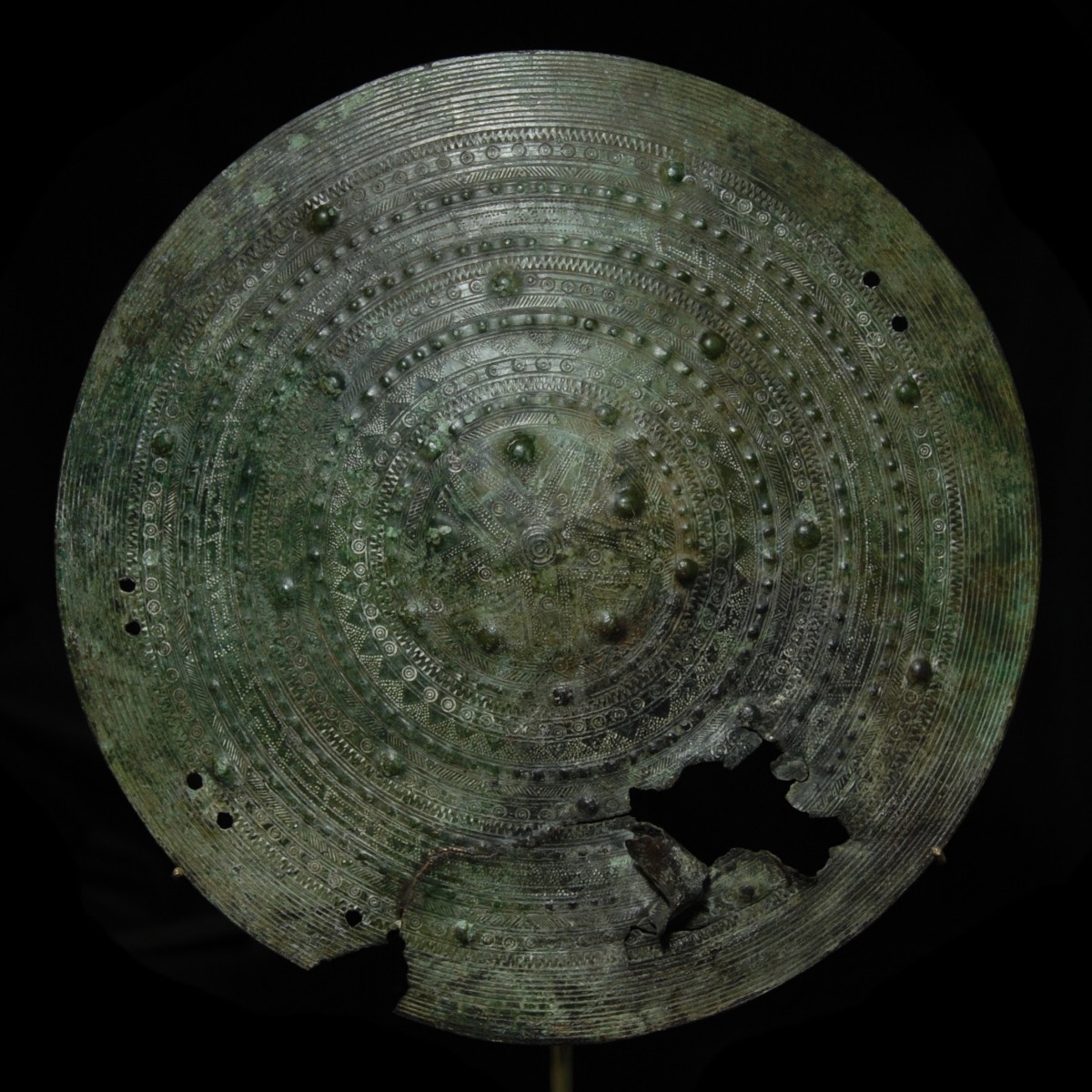
|
|
|
|
Etruria– 1st half of 7th century B.C.
|
Very abundantly decorated, slightly convex bronze breastplate. Concentric circles punched in the center, from which five star-shaped arms with dotted outer sides extend, between which knobs are arranged. Outgoing from this knobbed cross, extremely fine ornamental bands that are decorated with hatched and punched internal engraving in the form of zigzag lines, circular eyes, triangles and lines, among other things. A total of four pairs of holes near the rim for suspension to the leather. Disks like this were worn as armor to protect the heart, which is why they are also known as kardiophylaxes. Mounted.
|
Provenance: From an old Dutch collection.
Dimensions: 24.5 cm in diameter
Price: 8 000 Euro
|
|
|
|
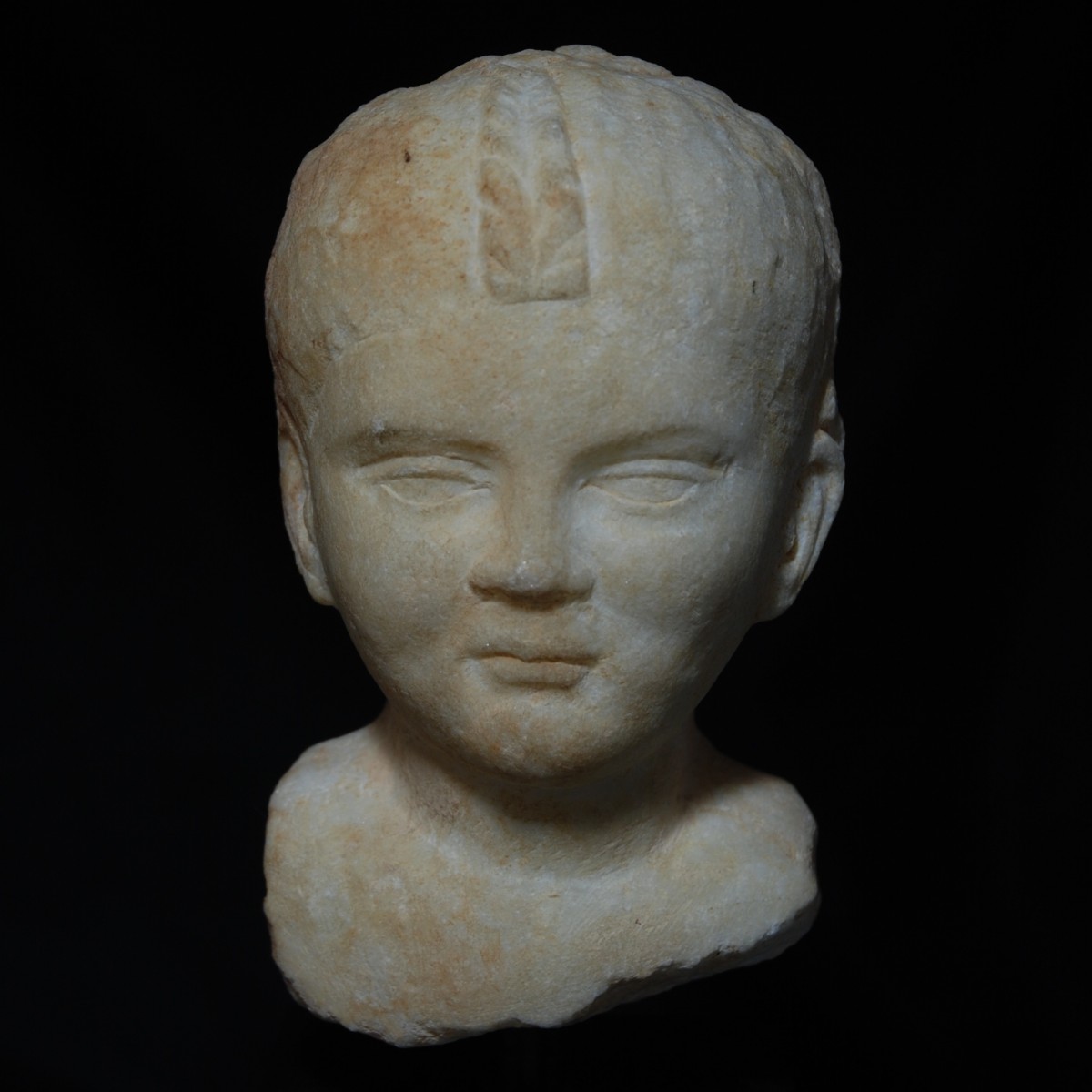
|
|
|
|
|
|
Roman Empire – End of 1st century A.D.
|
Portrait bust of a girl with finely worked out features, prominent cheek bones and dimples, creating together with lowered eyelids and a closed mouth a face with a slightly melancholic expression. The girl wears in the centre on her head a braided ponytail, otherwise the hair is only schematically worked out. Neck and shoulders preserved. Possibly a portrait of a funerary relief. Mounted.
|
Provenance: French private collection, acquired in a Parisian auction house. Accompanied by a French antiquities passport.
Dimensions: 17.5 cm high
Price: 8 000 Euro
|
|
|
|
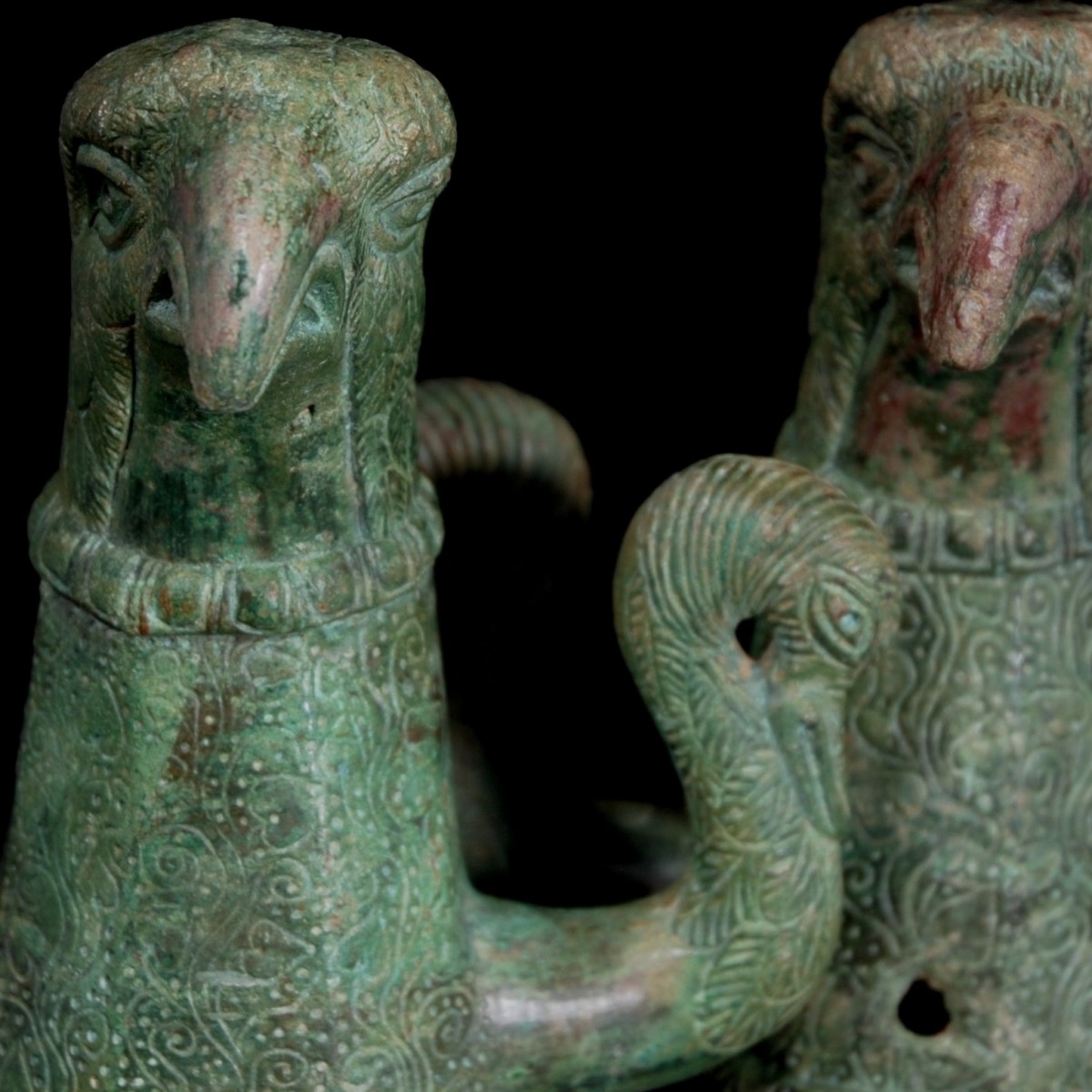
|
|
|
|
|
|
|
|
Roman Empire – 2nd -3rd Century A.D.
|
Massive bronze chariot fittings from a two-axle Roman traveling wagon, each with an eagle's head and two arms. The arms end in tilted swan's heads. Very fine details like the feathers in cold work. The octagonal floor is open and was attached to the side of the traveling chariot. Leather straps were then stretched over the arms to carry the vehicle body with the passengers. So uneven ground should be leveled out making travelling more comfortable. Simply spoken, these exceptional bronze fittings are shock absorbers from antiquity. Compare the type of chariot fittings with eagle head at Christie's auction on June 10, 2010, lot 155.
|
Provenance: Collection K. K., Great Britain, aquired in the 1950s. Thence Gorny & Mosch auction on 16 June 2016, lot 48. Last in the private collection E. W., Vienna, Austria.
Dimensions: each 14.7 cm high
Price: 6 000 Euro
|
|
|
|

|
|
|
|
|
|
Egypt – Late period, 664-332 B.C.
|
Blue-green glazed faience amulet of the dwarf god Pataikos. He stands with his bent legs on two crocodiles, whose heads are turned inward. The hands rest on the fat belly and hold two knives. Pataikos wears a multi-link necklace and a scarab sits on his flattened head. On the back a winged deity with a solar disk. Between the sun disk and Pataiko’s back of the head there is a continuous hole for suspension. An engraved Horus eye at the bottom, which probably served as a stamp seal. A rare Pataikos amulet.
|
Provenance: Sotheby's auction on 4 December 1978, lot 81. Thence in a Swiss collection. Thence Bonhams London auction on 6 July 2017, lot 84. Last in a New York private collection.
Dimensions: 5.9 cm high
Price: 3 200 Euro
|
|
|
|

|
|
|
|
|
|
Greece/Canosa – 3rd century B.C.
|
Finely worked out incense burner (thymiaterion) in the form of a woman's head, which rests on a square plinth. The face with graceful features is framed by a wreath of leaves and fruits. Long, cone-like earrings hang down at the side. The head is crowned by a large calyx, the outside of which is decorated with floral patterns. Beautiful white and red color remains. A round venting hole at the back of the head.
|
Provenance: From a southern German private collection, acquired 1975 from Galerie Wettstein in Essen, Germany. With original certificate by H. Wettstein.
Dimensions: 19.8 cm high
Price: 4 800 Euro
|
|
|
|
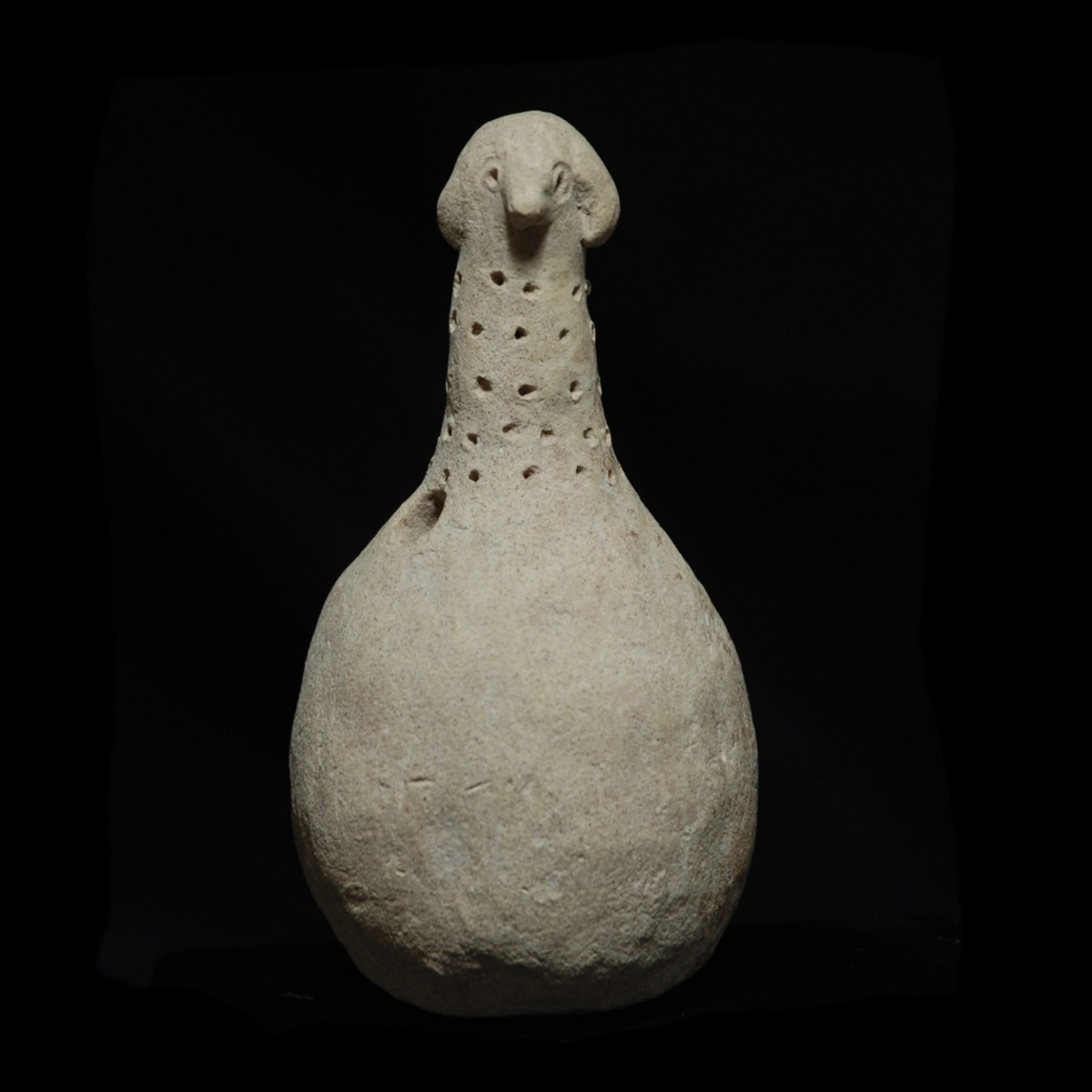
|
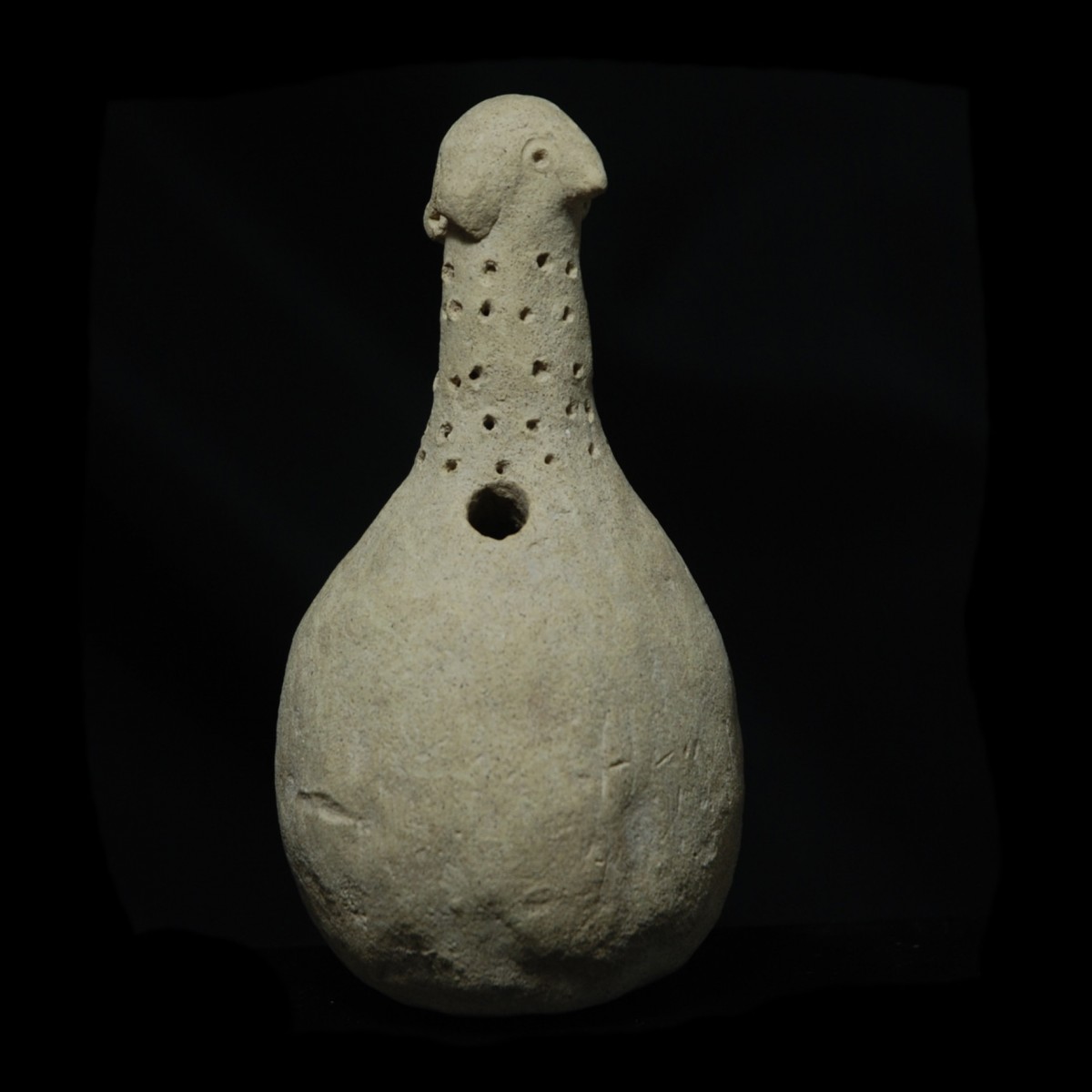
|
|
Levant – 1st half of 2nd millennium B.C.
|
Bulbous clay figure with a stylized bird's head, which has a large drilled opening on the side of the neck. If you place your lips there and gently blow into it, you will hear a melodious flute tone. The long neck with numerous small holes. The head with a pointed, prominent nose, small pierced eyes and long hair that cascades to the sides and back. A rare type.
|
Provenance: New York private collection, acquired in the 1970s from the Merrin Gallery.
Dimensions: 10 cm high
Price: 1 600 Euro
|
|
|
|
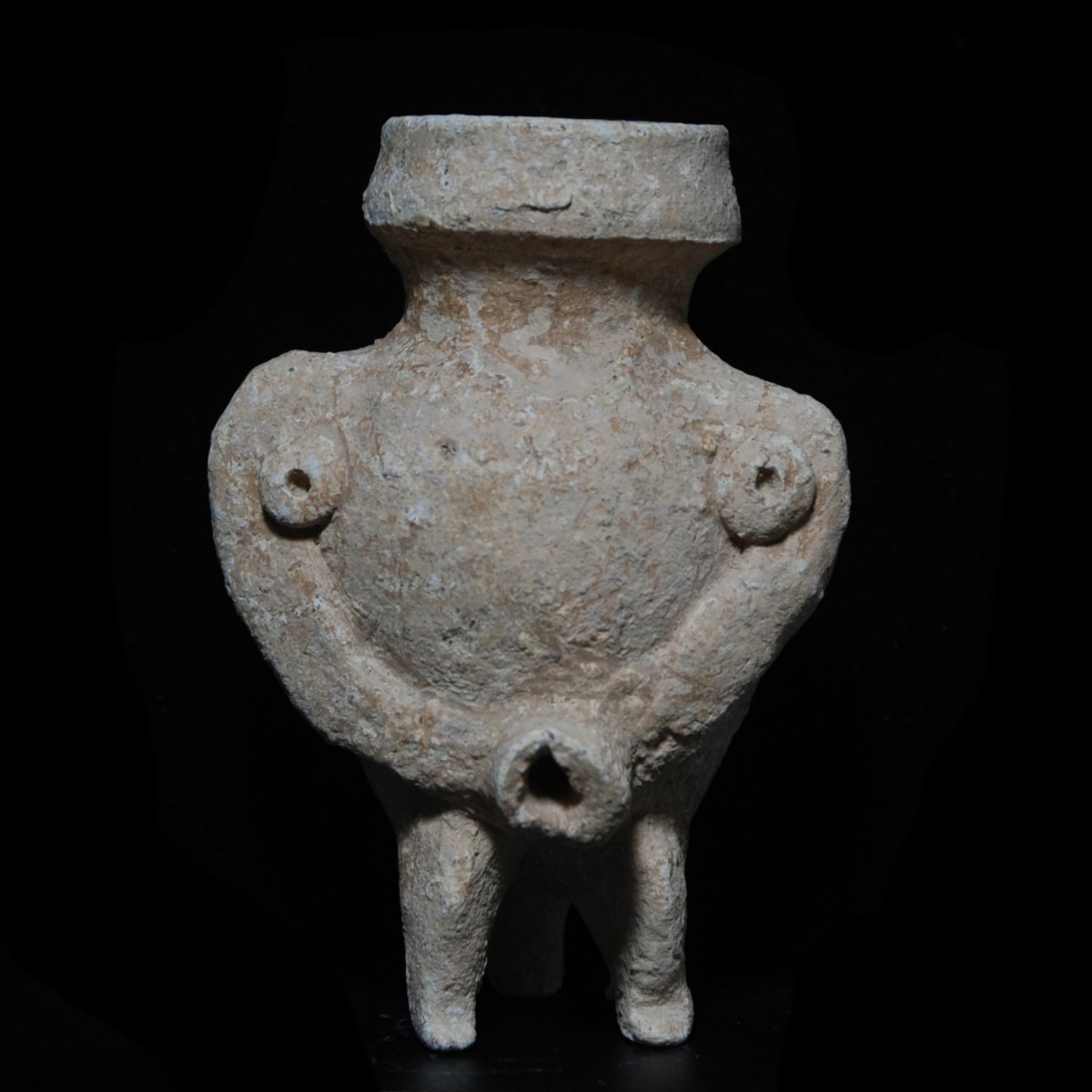
|
|
|
|
|
|
Levant – Early 2nd millennium B.C.
|
Particularly charming, anthropomorphic terracotta vessel in the shape of a stylized man who holds with both hands his genitals, which also serve as a spout. The bulbous body of the vessel stands on three slightly angled legs. Applied rings with a punched center, which are attached under the armpits, indicate the nipples. The head is formed by the set off rim with a smooth outside.
|
Provenance: Private collection Shlomo Moussaieff (1925-2015), Israel. Acquired between 1948 and 2000.
Dimensions: 10 cm high
Price: 1 800 Euro
|
|
|
|
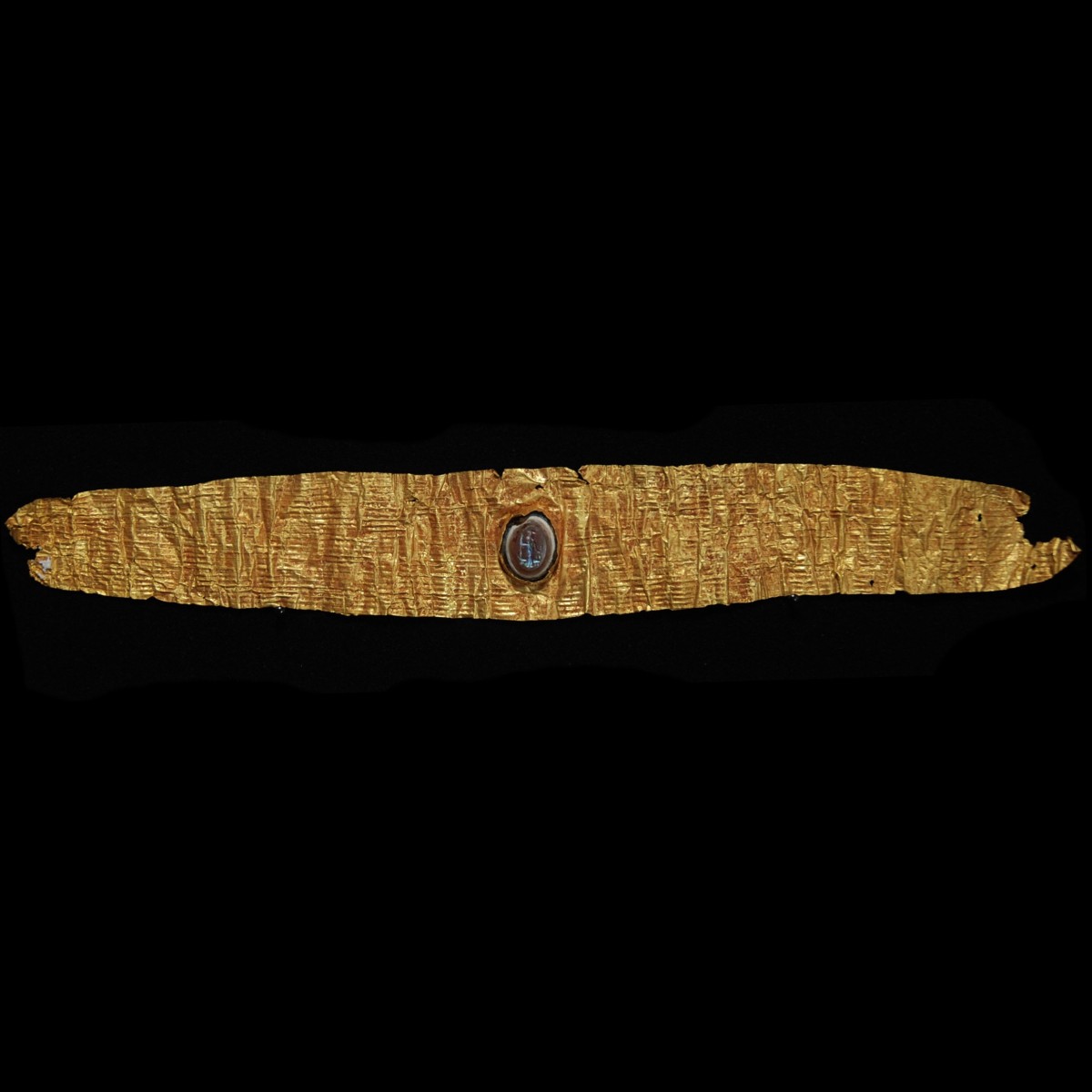
|
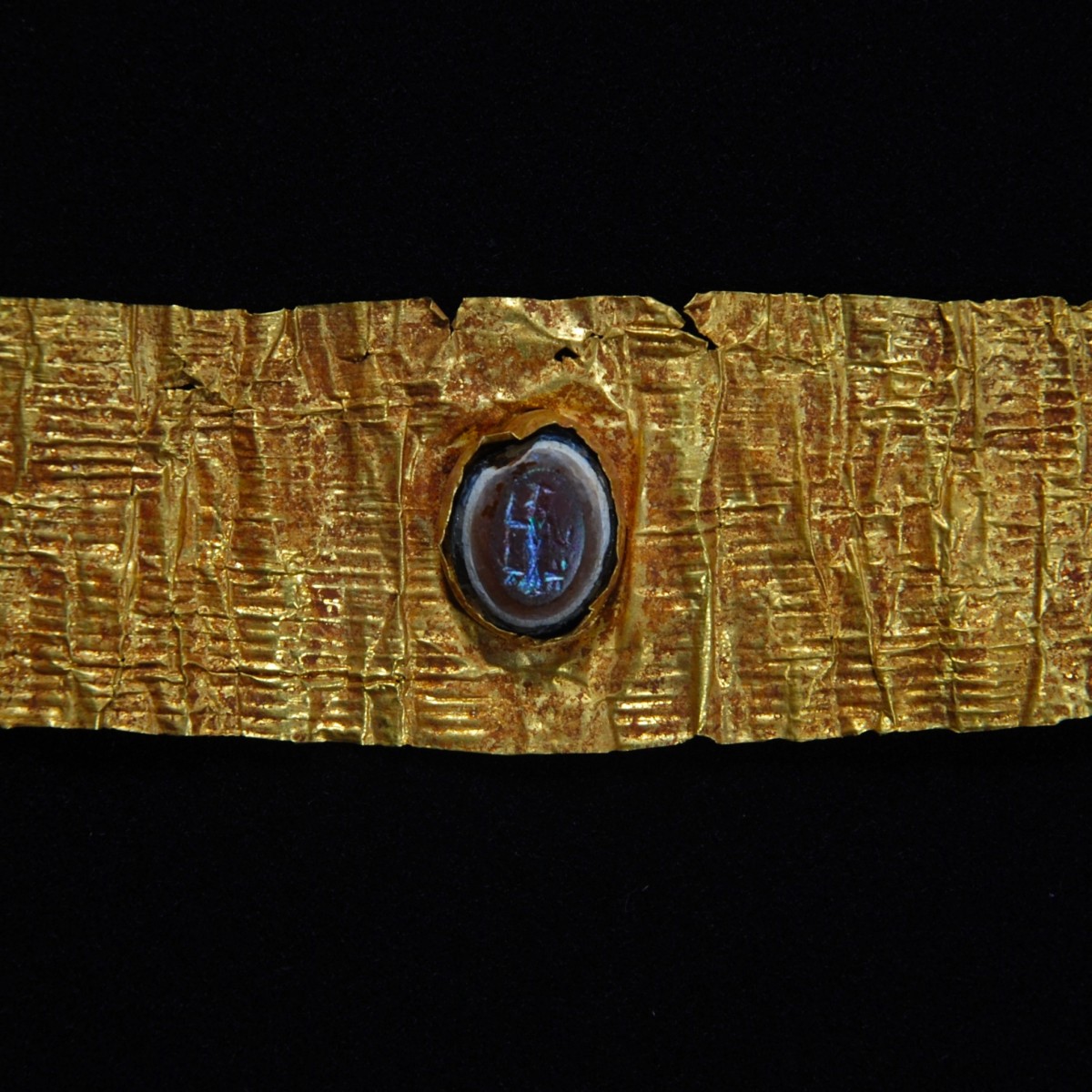
|
|
|
|
Roman Empire – 1st-2nd century A.D.
|
Diadem made of gold leaf with embossed fine, horizontal line decoration. In the center sits a two-layered glass intaglio in a gold leaf setting, which imitates a layered agate. Jupiter Heliopolitanus is depicted with his right hand raised in which he is holding the whip. In his left hand, which is held down to the side, he is possibly holding ears of grain which are typical for him. At his feet two stylized animals, probably bulls, to the left and right. The gem with beautiful iridescence. A rare diadem probably from the eastern Mediterranean Sea. In today's Balbeek (ancient Colonia Heliopolis) in Lebanon stood the most famous sanctuary where Jupiter Optimus Maximus Heliopolitanus was worshiped. Placed on a black base plate.
|
Provenance: Private collection Léon Rodrigues-Ely (1924-1973), Marseille, France.
Dimensions: 23.3 cm long
Price: 2 400 Euro
|
|
|
|
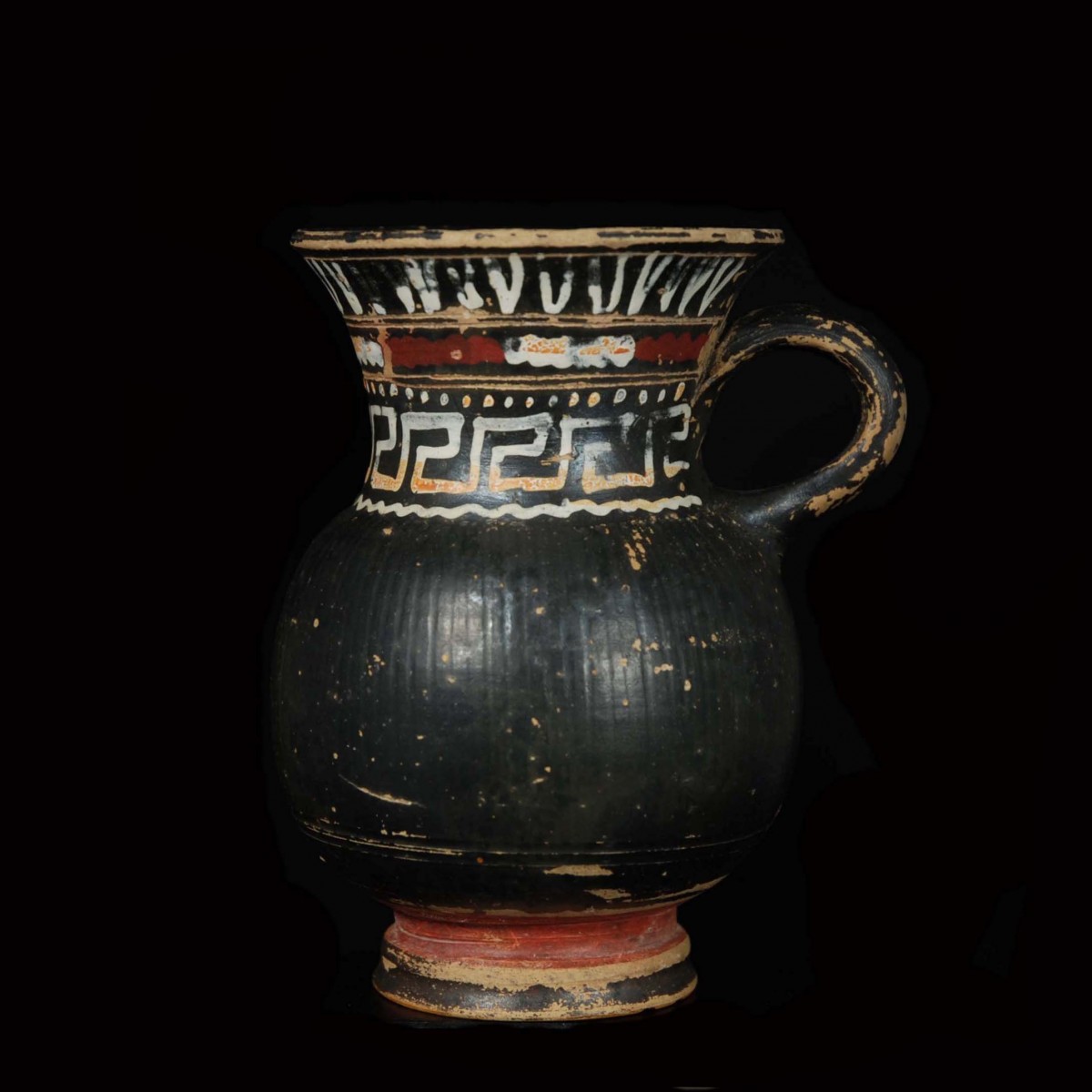
|
|
Greece/Gnathia – 2nd half of 4th century B.C.
|
Finely crafted, black glazed jug with red, yellow and white painting. The bulbous, ribbed corpus stands on a finely profiled, slightly offset ring base. The neck with a yellow and white meander, underneath a white wavy line and above it dotted decoration. White tongues all around the rim, underneath floral decoration in red and white between thin, yellow lines. The circular handle starts at the neck and ends on the shoulder. The rim is curved outwards in a funnel shape.
|
Provenance: Rhenish private collection, 1980s. Thence Gerald Ebinger collection, Vienna, Austria.
Dimensions: 11.3 cm high
Price: 480 Euro
|
|
|
|
|
|
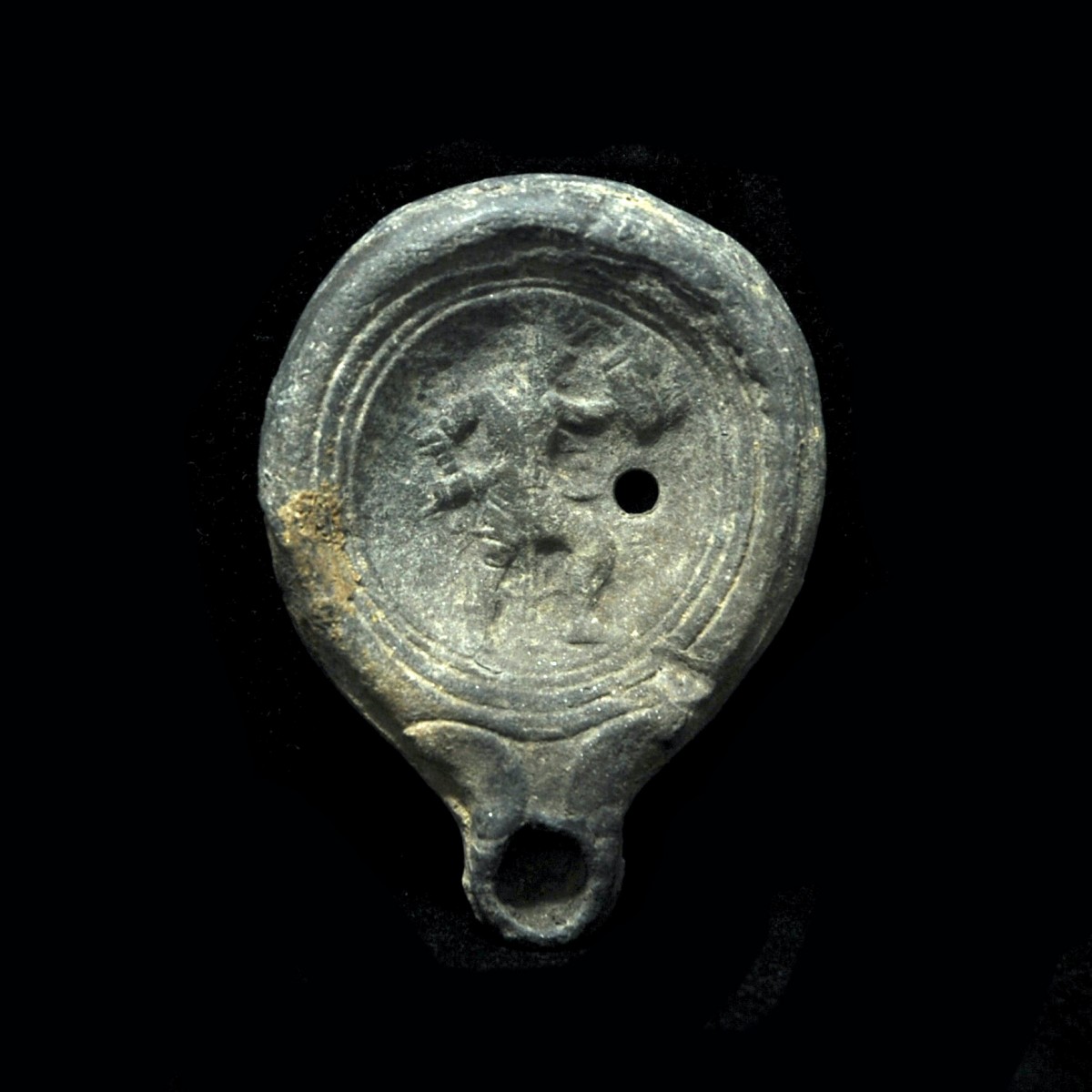
|
|
Roman Empire – 1st century A.D.
|
Terracotta oil lamp of type V according to Loeschke, with volute on the shoulder and rounded snout. On the mirror a gladiator in a defensive position. For the depiction see the lamp 435 with Loeschke (“Lampen aus Vindonissa”, Zurich 1919).
|
Provenance: German private collection Claus-Eberhard Schultze, Berlin, Germany.
Dimensions: 8.5 cm long
Price: 480 Euro
|
|
|
|
|
|
Spazieren Sie mit uns durch
Jahrtausende voller Kunst
|
|
|
Unser Highlight des Monats:
|
Messen, Ausstellungen, Vernissagen – alles, was wir an Kunst-Events so lieben, ist derzeit (noch) nicht möglich. Doch: Unser Showroom in Wien ist für Sie geöffnet! Schauen Sie vorbei, und spazieren Sie mit uns durch die Jahrtausende. In den letzten Monaten ist es uns gelungen, zahlreiche antike Meisterwerke zu erwerben. In allen Preisklassen. Von Ägypten bis Rom.
|
Nicht zuletzt: Wenn Sie noch eine jahrtausendealte Überraschung für Ostern suchen, haben Sie gute Chancen bei den über 500 Objekten bester Provenienz in unserem Showroom fündig zu werden.
|
|
|
Römisches Reich – 2. Jahrhundert n. Chr.
|
Lebensgroßes Statuenfragment eines Mannes, der eine Tunika unter einer langen, voluminösen Toga trägt („Togatus“). Der linke Arm ist abgewinkelt nach vorne gestreckt, der rechte hängt gerade seitlich am Körper herab. Die Toga verläuft horizontal über den Bauch und ist über die linke Schulter geschlagen, das Endstück ist dabei über den gerafften horizontalen Teil gesteckt. Mit wunderbar ausgearbeitetem, dichtem Faltenwurf.
|
Provenienz: Französische Privatsammlung aus der ersten Hälfte des 20. Jahrhunderts. Zuletzt in einem Pariser Auktionshaus.
Höhe: 55 cm
Preis: 48.000 Euro
|
|
|
|
Ausgewählte Kunstwerke des Monats:
|
|
Griechenland/Apulien – 340-320 v. Chr.
|
Bedeutendes Ensemble von drei überaus fein gearbeiteten, rotfigurigen Tellern mit Details in Deckweiß, das von Arthur D. Trendall der Menzies Gruppe, Gruppe des Triester Askos zugeschrieben wird. Ein Teller zeigt eine sitzende Göttin oder Priesterin in ein langes Gewand gehüllt. Sie hält ein gestreiftes Zepter und trägt ein prachtvolles Diadem. Vor ihr steht ein fein gemaltes Thymiaterion auf geschwungenen Tierbeinen. Hinter dem aufwendig gearbeiteten Thron der Göttin Tänien. Die Szene wird von einem Band Lorbeerblätter gerahmt. Die beiden anderen Teller zeigen jeweils einen unbekleideten Eros mit aufgestellten Flügeln. Auf einem steht Eros mit dem linken Bein auf einem Felsen und hält sich einen Spiegel vors Gesicht. Der andere Teller zeigt Eros nach links laufend mit Fächer und Haarband. Aufwendige Blüten und Pflanzen verzieren beide Szenen. Der Eros am Felsen wird von einem Wellenband gerahmt, der laufende von Lorbeerblättern. Alle drei Teller weisen am Rand Zungendekor auf und stehen auf fein profilierten Ringfüßen. Die Teller wurden vom Archäologen Arthur D. Trendall, dem Experten für unteritalische Vasenmalerei, in handschriftlicher Korrespondenz der Menzies Gruppe und hier der Untergruppe des Triester Askos zugewiesen und in den „Supplements to the Red-figured Vases of Apulia“ veröffentlicht.
|
Provenienz: Privatsammlung Michael Minnick, New York, erworben von Robert Peters, PhD, New York in den 1980er Jahren. Mit einer Kopie der handschriftlichen Zuweisung durch A. D. Trendall.
Durchmesser: 22,6 cm, 22,6 cm und 22,8 cm
Preis: 16.000 Euro
|
|
|
|
|
Etrurien – 1. Hälfte 7. Jahrhundert v. Chr.
|
Überaus reich verzierte, leicht konvexe Brustplatte aus Bronze. Im Zentrum gepunzte konzentrische Kreise, von denen fünf sternförmige Arme mit puntierten Außenseiten ausgehen, zwischen denen Noppen angeordnet sind. Von diesem Noppenkreuz ausgehend überaus feine Ornamentbänder, die unter anderem mit schraffierter und punzierter Binnengravur in Form von Zickzacklinien, Kreisaugen, Dreiecken und Linien verziert sind. In Randnähe insgesamt vier Lochpaare zur Fixierung am Leder. Scheiben wie diese wurden als Rüstung getragen, um das Herz zu schützen, weshalb sie auch als Kardiophylax bezeichnet werden. Gesockelt.
|
Provenienz: Aus alter niederländischer Sammlung.
Durchmesser: 24,5 cm
Preis: 8.000 Euro
|
|
|
|
|
Römisches Reich – Ende 1. Jahrhundert n. Chr.
|
Porträtbüste eines Mädchens mit fein gearbeiteten Gesichtszügen, ausgeprägten Wangenknochen und Grübchen, die dem Gesicht gemeinsam mit den gesenkten Augenlidern und dem geschlossenen Mund einen leicht melancholischen Ausdruck verleihen. Das Mädchen trägt mittig am Kopf einen geflochtenen Scheitelzopf, das Haar sonst nur schemenhaft ausgearbeitet. Hals und Schulteransatz erhalten. Wohl das Porträt eines Grabreliefs. Gesockelt.
|
Provenienz: Französische Privatsammlung, erworben in einem Pariser Auktionshaus. Mit französischem Antikenpass.
Höhe: 17,5 cm
Preis: 8.000 Euro
|
|
|
|
|
Römisches Reich – 2.-3. Jahrhundert n. Chr.
|
Zweiarmige, massive Gurthalter eines wohl zweiachsigen römischen Reisewagens, auf denen jeweils ein Adlerkopf sitzt. Die Arme enden in geneigten Schwanenköpfen. Sehr feine Details in Kaltarbeit. Der achteckige Boden ist offen und wurde seitlich am Reisewagen befestigt. Über die Arme waren dann Lederbänder gespannt, die den Wagenkasten mit den Passagieren trugen. So sollten Bodenunebenheiten ausgeglichen und einigermaßen erträglich gemacht werden. Es handelt sich also vereinfach ausgedrückt um Stoßdämpfer der Antike. Vergleiche zum Typus die Gurthalter mit Adlerkopf bei Christie's Auktionen am 10. Juni 2010, Los 155.
|
Provenienz: Sammlung K. K., Großbritannien, erworben in den 1950er Jahren. Danach Gorny & Mosch Auktion vom 16. Juni 2016, Los 48. Zuletzt in der Privatsammlung von E. W., Wien.
Höhe: je 14,7 cm
Preis: 6.000 Euro
|
|
|
|
|
Ägypten – Spätzeit, 664-332 v. Chr.
|
Blaugrün glasiertes Fayence-Amulett des zwergwüchsigen Gottes Pataikos. Er steht mit seinen abgewinkelten Beinen auf zwei Krokodilen, deren Köpfe nach innen gewandt sind. Die Hände ruhen am dicken Wanst und halten zwei Messer. Pataikos trägt eine mehrgliedrige Halskette, am abgeflachten Kopf sitzt ein Skarabäus. Auf der Rückseite eine geflügelte Gottheit mit Sonnenscheibe. Zwischen Sonnenscheibe und Hinterkopf des Pataikos eine durchgehende Lochung zur Aufhängung. An der Unterseite ein graviertes Horusauge, das wohl als Stempelsiegel diente. Ein seltenes Pataikos-Amulett.
|
Provenienz: Sotheby's Auktion vom 4. Dezember 1978, Los 81. Danach in einer Schweizer Sammlung. Danach Bonhams London Auktion vom 6. Juli 2017, Los 84. Zuletzt in einer New Yorker Privatsammlung.
Höhe: 5,9 cm
Preis: 3.200 Euro
|
|
|
|
|
Griechenland/Canosa – 3. Jahrhundert v. Chr.
|
Fein gearbeitetes Thymiaterion in Form eines Frauenkopfes, der auf einer quadratischen Plinthe aufsitzt. Das Gesicht mit anmutigen Zügen wird von einem Haarkranz aus Blättern und Früchen eingerahmt. Ein langer, zapfenartiger Ohrschmuck hängt seitlich herab. Der Kopf wird von einem großen Blütenkelch bekrönt, dessen Außenseiten mit floralen Mustern verziert sind. Schöne weiße und rote Farbreste. Am Hinterkopf ein rundes Brennloch.
|
Provenienz: Aus süddeutscher Privatsammlung, erworben 1975 in der Galerie Wettstein in Essen. Mit Original-Gutachten von H. Wettstein.
Höhe: 19,8 cm
Preis: 4.800 Euro
|
|
|
|
Levante – 1. Hälfte 2. Jahrtausend v. Chr.
|
Bauchige Tonfigur mit stilisiertem Vogelkopf, die seitlich am Halsansatz eine große gebohrte Öffnung hat. Wenn man dort die Lippen ansetzt und leicht hineinbläst, ertönt ein wohlklingender Flötenton. Der lange Hals mit zahlreichen kleinen Lochungen. Der Kopf mit spitzer, prägnanter Nase, kleinen gebohrten Augen und langen Haaren, die seitlich und hinten herabfallen. Ein seltener Typus.
|
Provenienz: New Yorker Privatsammlung, erworben in den 1970er Jahren in der Merrin Gallery.
Höhe: 10 cm
Preis: 1.600 Euro
|
|
|
|
|
Levante – Frühes 2. Jahrtausend v. Chr.
|
Überaus reizvolles, anthropomorphes Terrakotta-Gefäß in der Form eines stilisierten Mannes, der mit beiden Händen sein Geschlecht umfasst, das gleichzeitig als Ausguss dient. Der bauchige Gefäßkörper steht auf drei leicht abgewinkelten Beinen. Applizierte Ringe mit gepunzter Mitte, die unter den Achseln angebracht sind, deuten die Brustwarzen an. Den Kopf bildet die abgesetzte Öffnung mit glatter Außenseite.
|
Provenienz: Privatsammlung Shlomo Moussaieff (1925-2015), Israel. Erworben zwischen 1948 und 2000.
Höhe: 10 cm
Preis: 1.800 Euro
|
|
|
|
|
Römisches Reich – 1.-2. Jahrhundert n. Chr.
|
Aus Blattgold gearbeitetes Diadem mit feiner, horizontaler Linienverzierung in Treibarbeit. Im Zentrum sitzt in einer Blattgoldfassung eine zweilagige Glasgemme, die einen Lagenachat imitiert. Dargestellt ist Jupiter Heliopolitanus mit erhobener Rechten, in der er die Peitsche hält. In seiner seitlich nach unten gehaltener Linken hält er wohl die für ihn typischen Ähren. Zu seinen Füßen zwei stilisierte Tiere, wohl Stiere, nach links und rechts. Der Schmuckstein mit schöner Irisierung. Ein seltenes Diadem wahrscheinlich aus dem östlichen Mittelmeer. Im heutigen Balbeek (antik Colonia Heliopolis) im Libanon stand das bekannteste Heiligtum, in dem Jupiter Optimus Maximus Heliopolitanus verehrt wurde. Auf schwarzer Grundplatte aufgelegt.
|
Provenienz: Privatsammlung Léon Rodrigues-Ely (1924-1973), Marseille, Frankreich.
Länge: 23,3 cm
Preis: 2.400 Euro
|
|
|
|
|
Griechenland/Gnathia – 2. Hälfte 4. Jahrhundert v. Chr.
|
Fein gearbeitete, schwarz glasierte Kanne mit roter, gelber und weißer Bemalung. Der bauchige, gerippte Korpus steht auf einem fein profilierten, leicht abgesetzten Ringfuß. Der Hals mit gelb-weißem Mäander, darunter weiße Wellenlinie und darüber Punktdekor. Am Rand umlaufend weiße Zungen, darunter florales Dekor in rot und weiß zwischen dünn gezogenen, gelben Linien. Der kreisförmige Henkel setzt am Hals an und endet auf der Schulter. Der Rand trichterförmig nach außen gewölbt.
|
Provenienz: Rheinische Privatsammlung, 1980er Jahre. Danach Sammlung Gerald Ebinger, Wien.
Höhe: 11,3 cm
Preis: 480 Euro
|
|
|
|
|
Römisches Reich – 1. Jahrhundert n. Chr.
|
Terrakotta-Öllampe des Typs V nach Loeschke mit Schultervolute und gerundeter Schnauze. Am Spiegel ein Gladiator in Ausfallsstellung. Zur Darstellung siehe die Lampe 435 bei Loeschke („Lampen aus Vindonissa“, Zürich 1919).
|
Provenienz: Deutsche Privatsammlung Claus-Eberhard Schultze, Berlin.
Länge: 8,5 cm
Preis: 480 Euro
|
|
|
|
|
|

|
|
|
|